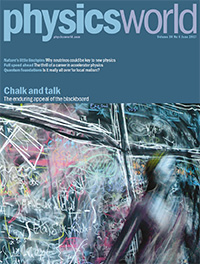Tag archives: Fermi
Fermilab at 50: the June 2017 issue of Physics World is now out
 By Matin Durrani
By Matin Durrani
With America’s iconic Fermi National Accelerator Laboratory (Fermilab) celebrating its 50th anniversary this month, check out the June 2017 issue of Physics World magazine, which is now live in the Physics World app for mobile and desktop.
Fermilab mades its name with the Tevatron proton–antiproton collider but neutrinos hold the key to the lab’s future, as Ben Still from Queen Mary University of London makes clear in a feature on the physics of these elusive particles.
You can also enjoy a cracking review of Tommaso Dorigo’s new warts-and-all account of life in the CDF collaboration at Fermilab, while Seyda Ipek from the lab pops up in Philip Ball’s homage to the blackboard – which you can also read on physicsworld.com.
Plus don’t miss this month’s Lateral Thoughts, which reveals how one physicist working in a Scottish call centre ended up chatting to Enrico Fermi’s daughter-in-law about her TV.
Remember that if you’re a member of the Institute of Physics, you can read Physics World magazine every month via our digital apps for iOS, Android and Web browsers.
View all posts by this author | View this author's profile
Physicists in motion: immigration and the Nobel prize

Around the world: how has immigration shaped the global physics community? (Courtesy: iStockphoto/Joel Carillet)
By Hamish Johnston
In December 1938 Enrico Fermi travelled to Stockholm, where he was presented with that year’s Nobel Prize for Physics for his insights into the atomic nucleus. But after the ceremony, Fermi did not return to his native Italy. Instead, he joined his wife and young children on a voyage to the US. Fermi went on to make major contributions to physics in that country – including playing crucial roles in developing nuclear weapons and nuclear energy.
View all posts by this author | View this author's profile
Mysterious ‘superflares’ confound astronomers
By Tushna Commissariat
Most of us with an interest in astronomy would recognize the Crab Nebula in images and videos quite readily. The supernova remnant, first seen on Earth in the year 1054, consists of a super-dense neutron start that spins about 30 times an second, making it a pulsar that swings a beam of radiation towards Earth, like a lighthouse.
NASA’s Fermi Gamma-ray Space Telescope is one of many that look for high-energy radiation sources, and recently the Crab Nebula has caught its eye. The past seven months have seen some rather dramatic variations within the nebula, with Fermi and other telescopes noticing X-ray flares a hundred times brighter than seen ever before.
Since 2009 Fermi has detected several short-lived gamma-ray flares at energies greater than 100 million electron volts (eV), which is much higher than the flares seen before. On 12 April Fermi detected a flare that grew about 30 times more energetic than the nebula’s normal gamma-ray output and about five times more powerful than previous outbursts. On 16 April an even brighter flare erupted, which lasted for a few days before the activity died out.
“These superflares are the most intense outbursts we’ve seen to date and they are all extremely puzzling events,” says Alice Harding of NASA’s Goddard Space Flight Center. “We think they are caused by sudden rearrangements of the magnetic field not far from the neutron star, but exactly where that’s happening remains a mystery.”
When Fermi noted the variances in 2010 it alerted NASA’s Chandra X-ray Observatory, which began routinely monitoring the nebula to identify X-ray emissions associated with the outbursts. When Fermi scientists alerted the astronomers at Chandra about the spike in April, a pre-planned set of observations using the observatory was initiated.
Unfortunately, no clear evidence was seen for correlated flares in the Chandra images, so the reason for the sudden extreme variations is still a mystery. Theorists have deduced that the flares must arise within about one-third of a light-year from the neutron star, but efforts to locate them more precisely have been unsuccessful.
Scientists believe the flares occur as the intense magnetic field near the pulsar undergoes sudden structural changes. Such changes can accelerate electrons to velocities near the speed of light. As these relativistic electrons interact with the magnetic field, they emit gamma rays. To account for the observed emission, scientists say the electrons must have energies 100 times greater than can be achieved in any particle accelerator on Earth. This makes them the highest energy electrons associated with any source within our galaxy.
Take a look at the wonderful video by NASA that shows the changes as seen by Chandra, as well as some spectacular shots of the nebula.
View all posts by this author | View this author's profile